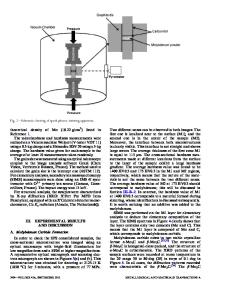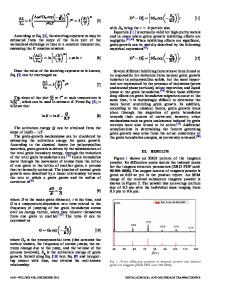Densification of Al 2 O 3 powder using spark plasma sintering
- PDF / 316,952 Bytes
- 6 Pages / 612 x 792 pts (letter) Page_size
- 73 Downloads / 338 Views
Al2O3 powders with four different particle sizes were densified using a spark plasma sintering (SPS) apparatus under three different sintering conditions: holding time, heating rate, and mechanical pressure. The Al2O3 powder compact sintered at a higher heating rate produced a sample with a higher density and a fine-grained microstructure, while abnormal grain growth and a lower density resulted when a lower heating rate was applied, though the sintering temperature and holding time were the same in both cases. This revealed that rapid sintering by SPS was effective for promoting the densification of the powder. However, the powder with a coarse particle size was hard to sinter at a higher heating rate. Microstructural observation revealed that the edge part was denser than the inside of the sample when the holding time was short. Increasing the holding time made it possible for the inside to be sintered almost as dense as the edge part. Mechanical pressure was found to enhance densification of the Al2O3 powder. On the basis of these results, the SPS process is discussed.
I. INTRODUCTION
Plasma activated sintering (PAS) and spark plasma sintering (SPS) apparatuses were developed in 1988 and 1990, respectively.1 Since then, a variety of materials such as metallic materials,2,3 structural ceramics,4,5 oxide superconductors,6,7 ceramic composites,8,9 polymers,10 thermoelectric materials,11 and functionally graded materials (FGMs)12,13 have been prepared by SPS and PAS. SPS and PAS apparatuses are somewhat like the conventional hot-press. However, a pulse electric current and/or a direct current are applied directly to the graphite mold in SPS and PAS. Thus, the graphite mold and punches act as heating elements, which is different from the case of the hot-press. In SPS, a pulse electric current is employed for heating, while generally in PAS a pulse electric current is first applied for a short period and then a direct current is used. Details of the PAS and SPS apparatuses can be found elsewhere.14,15 Recently, there has been growing interest in clarifying the sintering process of SPS and PAS, focusing on whether plasma is generated or not by the pulse electric current. According to Ishiyama,14 PAS is a technique to sinter metallic powder, possibly resulting in the generation of plasma among the metallic particles when pulse voltage is applied, which would purify and activate the particles to be sintered. Tokita15 observed neck formaa)
Present address: Shanghai Institute of Ceramics, Chinese Academy of Sciences, 1295 Dingxi Road, Shanghai 200050, People’s Republic of China. 982
http://journals.cambridge.org
J. Mater. Res., Vol. 15, No. 4, Apr 2000 Downloaded: 14 Jun 2014
tion among some bronze alloy grains after the SPS process and suggested that the neck formation was attributed to the effect of spark plasma caused by the pulse electric current. Furthermore, in sintering of non-metallic materials, plasma generation by pulse electric current was also suggested in both PAS16 and SPS.17 Risbud et al.16 observed cl
Data Loading...











